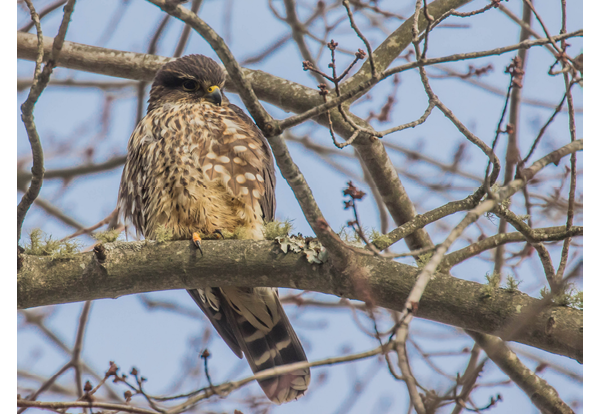Wayne R. Petersen

David M. Larson
The mystery bird de jour has all the features of a raptor, most notably its stout, prominently hooked beak and the long talons visible on at least two of its toes. Before proceeding further in this analysis, readers are reminded that the identification of perched raptors can often be surprisingly challenging.
Having spent countless hours watching hawks in flight at various hawk-watching locations and in the course of regular birding at many different locations, I am constantly impressed by the apparent facility with which many birders routinely identify flying or soaring hawks, often at considerable distances. However I have also had numerous encounters with birders struggling over the identity of a perched raptor, and I include myself in this category! Because many raptors are more often viewed in flight than when perched, this phenomenon may not be surprising, although it does beg the question about the accuracy of certain distant flight identifications.
With this caveat in mind, we fortunately have an outstanding image of a perched bird to work with. A quick assessment of the picture reveals a chunky, large-headed raptor that has a short-tail with two or three conspicuous white bands, as well as a thin white line over and behind the eye. Additionally, the pictured bird has a vertically streaked breast with the streaks merging into largish dark and white blotches along the sides. It also shows several thin streaks on the crissum (undertail coverts).
Given the bird's stocky and neckless appearance, blocky head shape, relatively short tail, and primaries that extend well down onto the tail, the bird clearly is not an accipiter (i.e., Cooper's or Sharp-shinned hawk). Additionally, the presence of streaks on the crissum is uncharacteristic of an accipiter. Adults of both Red-shouldered and Broad-winged hawks have prominent white tail bands, but in Broad-wings the bands are wide, often with only one wide band visible on a perched individual. Immatures of both of these species lack conspicuous white tail bands. The long primary length relative to the tail length of the mystery bird, and its chunky, compact appearance do not suggest Red-shouldered Hawk, and in the website version of the image, it is obvious that the rich, rusty orange found on the underparts of an adult Red-shoulder is absent.
With these features in mind, the pictured bird can only be one of two small falcons—Merlin or the similarly-sized American Kestrel. Though these two species can superficially resemble one another both perched and in flight, kestrels always exhibit two clear, black, facial markings—one resembling an ear patch and the other a sideburn. Kestrels, unlike the pictured falcon, also have a rusty tail without clear white bands. And structurally, kestrels are slimmer and less heavily marked underneath. The mystery raptor is therefore a Merlin (Falco columbarius). Because of the difficulty in distinguishing immatures from adult females, the age of the pictured bird is uncertain, but is most likely an adult female.
Merlins are uncommon to fairly common spring and fall migrants in Massachusetts, mainly along the coast, but also increasingly inland. They are also regular in small numbers in winter, often appearing in urban areas where they have all but replaced the beleaguered American Kestrel these days. Not only have Merlins increased as migrants and in winter, there has been an increasing number of nesting occurrences in Massachusetts. David Larson photographed this Merlin in Taunton, Massachusetts, on December 30, 2017.
Wayne R. Petersen